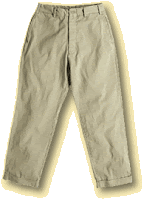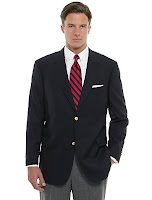
World War II ended and the soldiers came home. With them they brought the military contract work trousers that had taken them through Germany, North Africa and Southeast Asia. They were tough as steel and, eventually, soft as flannel and remarkably dashing. The best part was that they looked good with a uniform shirt, but they made the transition to a sport-shirt easily.
Then, sometime in the 1980s, Levi, Strauss and Company got hold of them and made them into Dockers. The pants became more tailored, the fabric less resilient, and the construction became that of Chinese national slave labor. What had once been unabashedly American, became trash.
Fortunately for us, for a price, good khakis are still available. Bills Khakis of Reading, Pennsylvania produces real, honest-to-God World War II style khaki pants. And you pay for them. They cost around a hundred dollars a pair, but, given the devaluation of the dollar and the quality of these trousers, they are truly well worth it. These get better with washings and soon your oldest pair will be your favorite. Bills Model 1 is cut in the 1930s style, full in the seat and legs. Gentlemen don't need pleats, though Bills does offer them, should you so desire.
The best part is that Bills now offers this traditional off-the-rack cut of slacks in a variety of fabrics and colors including corduroys and woolens.
These pants are definitely not your Dockers – the cut is full, the waist is high, the pockets are deep and the fabric is engineered to take Guadalcanal. Your grandkids will be fighting over these babies.
Cuffs or no cuffs? Personally, I like the look of cuffs on my slacks, mainly because that's the way Dad did it. When they were elements of uniforms, of course, they were finished plain. Plain hems give a more streamlined look to your trousers, but Bills Model 1s are not streamlined pants – they are baggy high-waisted pants. I think that cuffs give a more opulent look to the trousers, and Bills deserve to be showcased richly, so cuffs it is.
You will need to have several pair of khakis – a pair of crisply pressed khakis and a pair of faded and worn khakis. These are the staple of your wardrobe. Well pressed with a dress shirt, a necktie and a blazer these will take you through most interviews and dinner at the club. A bit rumpled with a sport-shirt and a pair of Top-siders, they will take you to the cocktail party at the marina. Truly these are the most versatile trousers in a gentleman's wardrobe, so don't skimp on them.
If Bills are unavailable in your area, look for trousers made of pure cotton – polyester/cotton blends, while better than they were two decades ago, still look cheesy. Plain fronts are better than pleats. Look for a full cut to ease movement. Details like watch pockets and flapped rear pockets are nice. Quality of construction, as with every element of your wardrobe, is essential. If they have advertising or brand names on the bum, carefully remove it. Rule of thumb: With the single and notable exception of blue jeans, you do not want advertising on your clothing.

